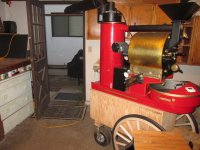MillCityRoasters
New member
Hi Doc.
Here's a slightly cautionary tale about safety. I had a visitor from Iowa here this weekend. He's a pretty sharp and capable guy. We roasted a batch and loaded a roaster in the back of his truck. I sent him the kludge of pdf's we usually send and told him to call my mobile number if anything didn't make perfect sense. Honestly, he's the last guy I would have ever expected to have a problem installing a roaster. He called me at 8:00 pm last night because he thought the transformer was step-down, not step-up. This means he wired the 120 volt side to a 208 volt outlet and stepped up his power to over 400 volts.
Think loud pop and billowing clouds of black smoke pouring from his roaster.
Whoops.
Everyone is greatly concerned about safety because people make mistakes and sometimes bad things happen.
As it turns out, he zorched the PID and the timer, but he worked around all that and roasted 10 lbs this morning. He's literally and figuratively stoked.
I sent him replacement parts today and he'll be good as new come Wednesday afternoon.
The moral of the story is a) the roaster is pretty hard to break and b) no cup of coffee is worth burning your house down.
Do exactly as you are doing: read the manual (such that it is), ask questions, and figure it out.
Oh, and no matter when or why, when in doubt call me.
Here's a slightly cautionary tale about safety. I had a visitor from Iowa here this weekend. He's a pretty sharp and capable guy. We roasted a batch and loaded a roaster in the back of his truck. I sent him the kludge of pdf's we usually send and told him to call my mobile number if anything didn't make perfect sense. Honestly, he's the last guy I would have ever expected to have a problem installing a roaster. He called me at 8:00 pm last night because he thought the transformer was step-down, not step-up. This means he wired the 120 volt side to a 208 volt outlet and stepped up his power to over 400 volts.
Think loud pop and billowing clouds of black smoke pouring from his roaster.
Whoops.
Everyone is greatly concerned about safety because people make mistakes and sometimes bad things happen.
As it turns out, he zorched the PID and the timer, but he worked around all that and roasted 10 lbs this morning. He's literally and figuratively stoked.
I sent him replacement parts today and he'll be good as new come Wednesday afternoon.
The moral of the story is a) the roaster is pretty hard to break and b) no cup of coffee is worth burning your house down.
Do exactly as you are doing: read the manual (such that it is), ask questions, and figure it out.
Oh, and no matter when or why, when in doubt call me.
Last edited:

